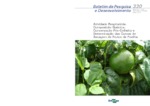Use este identificador para citar ou linkar para este item:
http://www.infoteca.cnptia.embrapa.br/infoteca/handle/doc/1071999| Título: | Atividade respiratória, composição química, conservação pós-colheita e determinação das curvas de secagem de frutos de fevilha. |
| Autoria: | RINALDI, M. M.  CONCEIÇÃO, L. D. H. C. S. DA   JUNQUEIRA, N. T. V.   LIMA, C. A. de   ANDRADE, L. S. de S.   |
| Afiliação: | MARIA MADALENA RINALDI, CPAC; LEO DUC HAA CARSON SCHWARTZHAUPT DA, CPAC; NILTON TADEU VILELA JUNQUEIRA, CPAC; CRISTIANE ANDRÉA DE LIMA, BOLSISTA CAPES; LUCIANA SOBRAL DE SOUZA ANDRADE, BOLSISTA CNPq. |
| Ano de publicação: | 2016 |
| Referência: | Planaltina, DF: Embrapa Cerrados, 2016. |
| Páginas: | 31 p. |
| Conteúdo: | Diversos estudos têm demonstrado o potencial de espécies do gênero Fevillea como matéria-prima para produção de biocombustíveis. O alto teor de óleo das sementes tem atraído o interesse da pesquisa. Por isso, este trabalho objetivou obter informações quanto à atividade respiratória de frutos de fevilha em diferentes pontos de desenvolvimento. As características químicas e fisiológicas foram avaliadas em diferentes ambientes. Determinaram-se: composição centesimal, teores de FDA, FDN, lignina, hemecelulose e atividade de água (aw) na casca e semente dos frutos secos em estufa com e sem circulação de ar. Realizaram-se estudos de conservação dos frutos sob condição ambiente, 7 ºC, 10 ºC e 15 ºC e determinação das curvas de secagem dos frutos sob condição ambiente, 60 ºC, 80 ºC e 105 ºC em estufa com e sem circulação de ar. A atividade respiratória dos frutos diferiu de acordo com o ponto de colheita, sendo maior em frutos em pleno estágio de desenvolvimento. A composição centesimal e físico-química dos frutos diferiu significativamente entre casca e semente e em relação ao método e temperatura de secagem. Frutos secos na temperatura de 60 ºC em estufa com circulação de ar apresentaram maior teor dos componentes estudados. A vida útil dos frutos mantidos sob refrigeração na temperatura de 10 ºC foi superior a 30 dias de armazenamento. Na condição de 7 ºC, eles apresentaram ?chilling? devido à baixa temperatura. Sob condição ambiente, os frutos apresentaram perda significativa de massa fresca, entretanto, ocorreram o surgimento de fungos e (ou) bactérias na superfície deles. O tempo de secagem em condição ambiente foi significativamente maior que nas temperaturas de 60 ºC, 80 ºC e 105 ºC. Não houve diferença significativa quanto ao tempo para atingir o ponto de equilíbrio em estufa com e sem circulação de ar. Abstract: Several studies have demonstrated the potential of species of the genus Fevillea as feedstock for biofuels production. The high oil content of the seeds has attracted the interest of research. Thus, the objective was to obtain information on the respiratory activity of fevilha in different points of development. Chemical and physiological features were evaluated in different environments. Centesimal composition, FDA, FDN, lignin, cellulose, hemicellulose and water activity (wa) in the bark and seed of fevilha dry were determined in an oven with air circulation and no air circulation. Studies were conducted on preservation of fruit fevilha under ambient condition, 7 °C, 10 °C and 15 °C and determination of the drying curves of fruit fevilla under ambient condition, 60 °C, 80 °C and 105 °C in an oven with air circulation and without air circulation. The respiratory activity of the fruits of fevilha differs according to the point of harvest of the fruits being higher in fruits in the full stage of development. The centesimal composition and physicochemical properties of fruits of fevilha differed significantly of the components in the bark and seed whereas the method and drying temperature. Dried fruits at a temperature of 60 °C in a kiln with air circulation show, generally, higher concentration of the components studied. The lifespan of the fruits of fevilha kept under refrigeration at a temperature of 10 °C is more than 30 days of storage. Provided 7 °C the same present chilling due to low temperature. Under environment condition, the fruits present significant loss of fresh mass what is desired in the drying process for extraction of oil from the seeds. However, there is occurrence of fungi and/or bacteria on the surface of the same. The drying time at ambient condition is significantly higher than the temperatures of 60 ºC, 80 ºC and 105 ºC. There is no significant difference in time to reach the breakeven point in kiln with and without air circulation. |
| Thesagro: | Biocombustível Óleo vegetal Armazenamento |
| Palavras-chave: | Fevilha Fevillea sp Produção de gás carbônico Composição centesimal Razão de umidade |
| Série: | (Embrapa Cerrados. Boletim de Pesquisa e Desenvolvimento, 330). |
| Tipo do Material: | Folhetos |
| Acesso: | openAccess |
| Aparece nas coleções: | Boletim de Pesquisa e Desenvolvimento (CPAC)  |
Arquivos associados a este item:
| Arquivo | Descrição | Tamanho | Formato | |
|---|---|---|---|---|
| Bolpd330.pdf | 2,18 MB | Adobe PDF |  Visualizar/Abrir |









